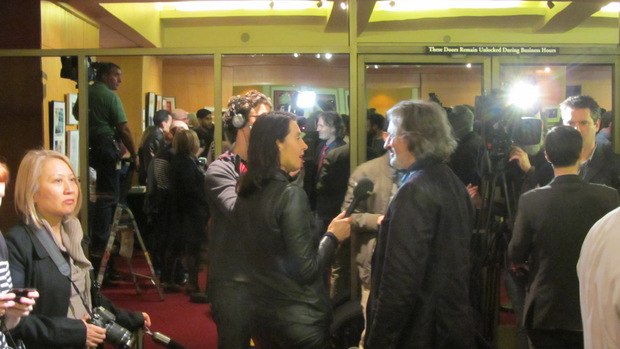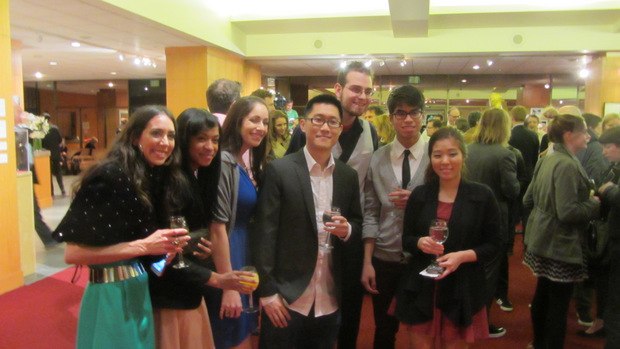Day 2 in LA concludes with a screening at the Motion Picture Academy hosted and moderated by Jason Schwartzman.
By Dan Sarto
Our day concluded with a special Motion Picture Academy reception and screening of both the animated and live action Oscar-nominated shorts, hosted by actor Jason Schwartzman. For the first time during the tour, all the animated short nominees were together in the same room, though of course, I could never manage to wrangle them all into one picture. I got close with four, but not all five. The Academy receptions are always nice, always classy and this was no exception. After a light meal gulped down way too fast and a glass filled with ice and 1 ounce of Diet Coke, I spotted PES for the first time, who unfortunately has been largely absent due to the birth of his second child the previous week. With sleep and sanity at a premium, he nevertheless joined us for the screening. It was great to catch up a bit. The last time I’d really spent any time with him was at an event in Germany several years ago.
The Academy theatre, which holds over a thousand people, was completely packed. Academy Governor John Bloom, currently the chair of the Short Films and Feature Animation Branch Executive Committee, opened the evening with a short status report detailing the continued growth of awareness and box office performance of the Academy’s short film theatrical runs. He went on to mention that this year, for the first time, the Academy distributed DVDs with all nominated shorts to every member, which generated greater awareness and voter participation. He then introduced Mr. Schwartzman, who subsequently handled his hosting and moderator duties quite well. He showed genuine interest in the films and filmmakers, interjecting humor and levity without being jokey or obnoxious.
In his opening remarks, he described how he likes all things short, including “short films, live action and animation, short stories…short songs, short phone calls… most things that are short.” He also talked about how shorts wouldn’t exist without passionate filmmakers who needed to tell their stories. After professing his love for the filmmakers, he invited everyone to put on their 3D glasses…and the animated short screening began.
The Q&A that followed the screening was quite lively, considering our filmmakers were sitting in front of ten times the usual number of audience members. Some of the highlights:
Jason Schwartzman: Why did you choose the style of animation that you presented tonight and how did it help you tell the story?
John Kahrs: I’m a CG guy. I was at Pixar for 10 years and I love that whole renaissance that has been happening. It’s really the golden age of CG right now. Tron made a huge impact on me as a kid. But when I moved down here to LA and started working at Disney, I think I was really enchanted by the drawings again, trying to figure out a way to bring that expressive line, the hand of the artist, back into the image again. That resulted in trying to that hybrid technique of bringing the two of them together. To me, it comes together in a way I’ve never seen before. It’s really the amazing engineering knowledge at Disney that has made that happen.
Tim Reckart: We had this concept, which of course you just saw, which potentially could have been done in 2D, with a bit more of a dollhouse approach. But I really wanted it to have a more magical, realist feel, that this universe of upward facing gravity was a world you could immerse the audience in. Stop-motion has this really great, intensely textural quality. The focus on miniatures exaggerates the natural textures that they have automatically. There is no extra work you have to do to get that. That makes the world these characters live in that much more tactile.
PES: I just like making things with my hands, basically. I love the idea that you can put anything in front of a camera and photograph it, and move it a little bit, and create the illusion of movement. That’s just an exciting process to me. In this film I animated my own hands, making guacamole. Obviously there was also animation of objects happening there as well. So it’s kind of a combination of a form of pixilation, which is animating the human body, and traditional form of stop-motion with inanimate objects, which is really one of the oldest art forms in cinema. I just love that immediacy of being able to say, “Here’s an object, let’s bring it to life.”
Minkyu Lee: I really wanted to describe Eden in a different kind of sense. 3D, 2D and stop-motion are not just different styles of animation, they really describe different worlds. They describe different physicalities. 3D animation is very exact in its portrayal of dimension and space, as opposed to 2D animation, in which I think there is a metaphysical, impressionistic not-exact quality to it. In describing Eden, that was something I wanted to do. There was something metaphysical about this place that was more of a mental state rather than a real stage. It was this strong impressionistic quality of drawing that I felt lent itself better to that world.
David Silverman: I did Maggie Simpson. It originally was going to be live action [laughter]. We decided to go in a direction more pantomime, which we do in small areas on The Simpsons. But we decided to go full pantomime to do something a little different.
At one point, as John was answering a two part question about the pressure of releasing his short theatrically, he asked Jason to repeat the second part again. The audience laughed when Jason replied, “Well it wasn’t even that great. Your answer was better than any part of my question.”
JS: [To Fondhla and Tim] Tell me about your creative process in working together. Is it like it was in the movie? [laughter]
TR: Film is a collaborative process and animation in some ways even more so. You don’t even have single actor to take credit for a performance. That’s spread across the animator, the voice actor and the character designer...My responsibility, as the director, is to craft the experience of the audience. Fondhla, in many ways, you were that test audience many times. I would come to you with some idea and you say, “No, that doesn’t work. Try again!”
Fondhla Cronin O’Reilly: When Tim came to me with the concept of the upside down world, he actually had the ending of the story first. So we developed the film backwards. We worked on the film together for four months, which was quite interesting.
Jason asked Minkyu Lee how long his film took to make, saying he had read it took five years. Minkyu corrected him and said two and a half. Jason came back and said he was going to round up and claim the film took five years to make. It got a big laugh. He continued, asking Minkyu how he got everyone to keep working on his film for so long. Minkyu replied, “Well, they had to because they were all my friends.” The audience roared again with laughter. He went to say that you basically have to be nice to them, supportive, buy them lots of lunches and occasionally cry.
With that, the animated short portion of the evening concluded. I made my fast exit during intermission, racing home to get ready for the next day at Sony Pictures Animation.
Dan Sarto is Publisher and Editor-in-Chief of Animation World Network.











